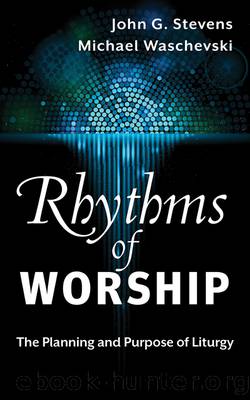Rhythms of Worship: The Planning and Purpose of Liturgy by John G. Stevens & Michael Waschevski

Author:John G. Stevens & Michael Waschevski
Language: eng
Format: epub
ISBN: 9781611645682
Publisher: Westminster John Knox Press
Published: 2014-09-15T00:00:00+00:00
1. Can you imagine church without Christmas or Easter or Pentecost? What does the calendar of feasts and festivals add to the life of the church?
2. In what ways does the liturgical calendar of special days and seasons âpresent us with patterns of growth in Christâ?
3. Who in your congregation is involved in planning for seasons like Advent and Lent? What is the process for planning these times?
Chapter Eight
Celebrating Christmas (and Epiphany)
What exactly is Christmas? What is its essential message? Before we can know how to celebrate Advent (the season of preparation for Christmas), we must form a clearer perception of what Christmas means for the life of the church. In our culture, multiple Christmases coexist side by side. There is the commercial Christmas, the cultural Christmas, the ethnic Christmas, the family Christmas, the office-party Christmas, the church Christmas, and more. The Christmas that we celebrate may be a complex blend of them all.
Christmas is generally understood to be the celebration of the birth of Jesus. But the actual date of Jesusâ birth is not known and probably not knowable. It is likely that December 25 was originally chosen to coincide with the Roman holiday Saturnalia, marking the Northern Hemisphereâs winter solstice, when the dark days of winter began to give way to longer, brighter days, promising spring. By 336 CE, churches in Rome were observing December 25 as Christmas, the day to celebrate the coming of Christ to be the âlight of the world.â
For the church, Christmas celebrates Emmanuel, âGod with us,â fulfilled in the birth, ministry, death, and resurrection of Jesus the Christ. Christmas celebrates the affirmation that âin Christ God was reconciling the world to himselfâ (2 Cor. 5:19). British theoretical physicist and theologian John Polkinghorne observes, âChristmas is the time when we mark and celebrate the beginning of the great revelatory act of the incarnationâ (emphasis added).1 He also comments, âThe doctrine of the incarnation . . . did not arise out of ungrounded speculation but out of the undeniable character of the encounter of the first disciples with the post-Easter Christâ (emphasis added).2
It is not enough for a congregation simply to settle for a churchly version of the secular Christmas. Christmas is the incarnation of God in human form that we celebrate! A casual mix of Christmas joy and a few old Christmas carols will not do for the churchâs celebration of this wonderful and significant festival. A predictable and culturally conditioned Christmas is not likely to make a difference in anyoneâs life. But the incarnation of God, reflected through our own encounter with the living Christ and articulated in our own authentic faith, can make a real difference in someoneâs life. This is why it is very important to plan the congregationâs celebration of Christmas with care and thoroughness.
Though the secular holiday glitters with spectacular displays everywhere we turn, and though the holiday season may awaken a powerful mix of human emotions and relationships, it can wear very thin as we experience too much to do and too little time to do it.
Download
This site does not store any files on its server. We only index and link to content provided by other sites. Please contact the content providers to delete copyright contents if any and email us, we'll remove relevant links or contents immediately.
| Church Administration | Church Growth |
| Church History | Church Institutions & Organizations |
| Church Leadership | Church Materials |
| Clergy | Ecclesiology |
| Ministry to the Sick & Bereaved | Pastoral Resources |
Fangirl by Rainbow Rowell(9035)
How to Bang a Billionaire by Alexis Hall(8042)
Wonder by R. J. Palacio(7882)
The Space Between by Michelle L. Teichman(6819)
The Thirst by Nesbo Jo(6770)
Assassin’s Fate by Robin Hobb(6064)
Wiseguy by Nicholas Pileggi(5618)
The Night Circus by Erin Morgenstern(5113)
The Kite Runner by Khaled Hosseini(5045)
Paper Towns by Green John(5031)
Bittersweet (True North #1) by Sarina Bowen(4764)
Gerald's Game by Stephen King(4521)
Too Much and Not the Mood by Durga Chew-Bose(4237)
Pillow Thoughts by Courtney Peppernell(4180)
Goodbye Paradise(3672)
Twelve Days of Christmas by Debbie Macomber(3471)
Good by S. Walden(3457)
The Rosie Effect by Graeme Simsion(3336)
The Cellar by Natasha Preston(3227)
